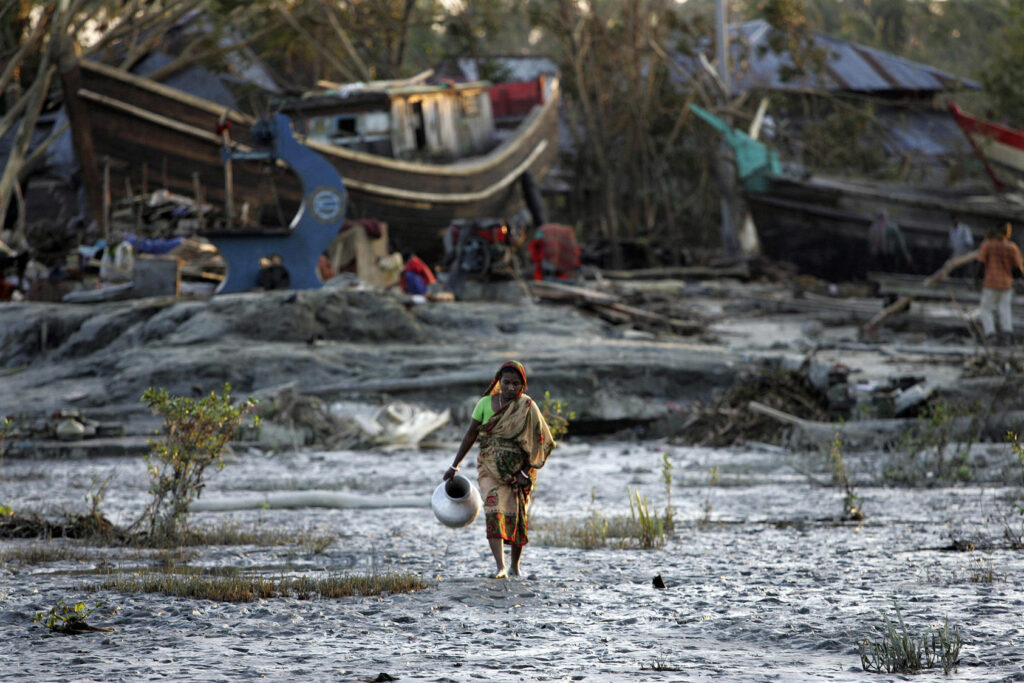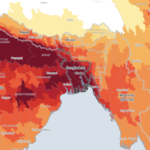Climate change in Bangladesh is causing a range of detrimental effects, including increased flooding, heightened health risks, and biodiversity loss. The country’s low-lying, flat topography and location in the Bengal Delta make it highly susceptible to flooding, with climate change intensifying the frequency and severity of extreme precipitation events.
Rising sea levels also pose a significant threat, leading to health hazards such as diarrhea and cholera, particularly in coastal areas. Additionally, climate change is damaging wetland ecosystems and their biodiversity, impacting critical habitats like the Sundarbans and breeding grounds for fish.
These challenges highlight the urgent need for climate action in Bangladesh to mitigate the impacts and ensure the sustainability of the country’s population.

Credit: www.researchgate.net
Introduction To Bangladesh’s Climate Crisis
Bangladesh is one of the most vulnerable countries to the adverse effects of climate change. The geographic location and topography of the country make it highly susceptible to natural disasters such as flooding, cyclones, and sea-level rise. These factors have a significant impact on the lives and livelihoods of the people of Bangladesh.
Geographic Vulnerability
The geographic vulnerability of Bangladesh stems from its low-lying and flat topography, which makes it prone to flooding and other climate-related hazards. The country’s location in the Bengal Delta further exacerbates its susceptibility to the adverse effects of climate change.
Historical Context Of Natural Disasters
Bangladesh has a long history of grappling with natural disasters, including floods, cyclones, and other extreme weather events. The frequency and intensity of these disasters have been exacerbated by the effects of climate change, posing significant challenges to the country’s development and the well-being of its population.
Rising Seas And Coastal Erosion
The effects of climate change in Bangladesh are starkly evident in the rising seas and coastal erosion, posing a significant threat to the country’s coastal communities. As sea levels continue to rise, the coastal areas of Bangladesh are experiencing accelerated erosion, leading to the loss of valuable land and infrastructure.
Impact On Coastal Communities
The rising seas and coastal erosion have a profound impact on the livelihoods and well-being of coastal communities in Bangladesh. Homes, agricultural fields, and vital infrastructure are being engulfed by the encroaching waters, displacing countless families and disrupting traditional ways of life. The erosion not only threatens the physical existence of these communities but also jeopardizes their socio-economic stability.
Salinization Of Freshwater Resources
In addition to the physical destruction caused by coastal erosion, the ingress of seawater into freshwater sources has led to the salinization of essential drinking water and agricultural resources. As a result, the availability of safe drinking water is dwindling, and agricultural productivity is declining, exacerbating food insecurity in these vulnerable areas.
Floods: A Recurring Nightmare
Bangladesh grapples with the devastating effects of climate change, leading to frequent and severe flooding. The country’s low-lying topography and increasing extreme precipitation events exacerbate the flood risk. Climate change also brings health hazards and biodiversity loss, posing a recurring nightmare for Bangladesh.
Increased Frequency And Severity
Floods have become a common occurrence in Bangladesh, and their frequency and severity have increased due to climate change. The country experiences both riverine and coastal flooding, causing immense damage to infrastructure, crops, and livelihoods. In recent years, the frequency and intensity of flooding have increased, leading to more significant losses and devastation.Challenges In Urban Areas
Urban areas in Bangladesh face unique challenges related to flooding. The rapid pace of urbanization and inadequate infrastructure exacerbates the impacts of flooding. The drainage systems are often overwhelmed, leading to waterlogging, and the low-lying areas are prone to flooding. Poor waste management and encroachment of water bodies further aggravate the situation. The urban poor, who live in informal settlements, are particularly vulnerable to flooding, as they lack access to basic amenities and are often located in flood-prone areas.Impact On Agriculture And Livelihoods
Agriculture is the backbone of Bangladesh’s economy, and flooding has a significant impact on the sector. The inundation of agricultural land destroys crops, leading to food shortages and loss of income for farmers. The livestock sector is also affected, as animals are often swept away in floods. The fishing industry, which provides livelihoods for millions of people, is also at risk, as floods damage fish farms and destroy fish habitats. Floods are a recurring nightmare for Bangladesh, and climate change is exacerbating the problem. The increased frequency and severity of flooding, particularly in urban areas, poses significant challenges for infrastructure, agriculture, and livelihoods. While the government has taken steps to mitigate the impacts of flooding, more needs to be done to ensure the country is resilient to the effects of climate change.
Credit: www.unicef.org
Cyclones: The Intensifying Storms
Bangladesh faces intensifying cyclones as a result of climate change, leading to increased flooding and damage to infrastructure. The rising sea levels and erratic rainfall patterns further exacerbate the country’s vulnerability to natural disasters, posing significant challenges to its population and economy.
Bangladesh, located in the Bengal Delta with its low-lying, flat topography, is highly prone to cyclones. With the impact of climate change, these storms have intensified, causing significant devastation and posing a threat to the country’s population and infrastructure.
Devastation Left Behind
The intensification of cyclones in Bangladesh has led to severe devastation. These storms bring powerful winds, heavy rainfall, storm surges, and flooding, resulting in the destruction of homes, infrastructure, and agricultural lands. The coastal areas, in particular, are vulnerable to the impacts of cyclones, with communities facing displacement, loss of livelihoods, and increased risk of injury and loss of life. The frequency and intensity of these storms have been on the rise, exacerbating the challenges faced by the country.
Adaptation And Mitigation Efforts
Recognizing the need to address the intensifying cyclones, Bangladesh has implemented various adaptation and mitigation efforts. These include early warning systems, improved cyclone shelters, and coastal embankments to protect vulnerable communities. Additionally, the government has focused on disaster risk reduction strategies and community-based initiatives to enhance resilience and preparedness. Efforts are also being made to promote sustainable land and water management practices to mitigate the impact of cyclones and reduce vulnerability.
Despite these efforts, the challenges posed by intensifying cyclones in Bangladesh remain significant. The country continues to face the need for continued investment in infrastructure, disaster management, and climate change adaptation measures to protect its population and ensure long-term sustainability. Collaboration between the government, international organizations, and local communities is crucial in addressing these challenges and building a resilient future for Bangladesh.
Health Hazards Escalating
The effects of climate change in Bangladesh are leading to escalating health hazards. Rising sea levels increase the risk of waterborne diseases like diarrhea and cholera, while heat stress and extreme weather events contribute to respiratory illnesses and mood swings.
The country’s vulnerability to flooding and extreme weather exacerbates these health risks, making it crucial to address the impacts of climate change on public health in Bangladesh.
Health Hazards Escalating: Climate change is causing a significant impact on human health in Bangladesh. The country is experiencing an increase in health hazards due to the rising temperature, changing rainfall patterns, and extreme weather events. The vulnerable population is at the highest risk of facing severe health issues. The health hazards are escalating in Bangladesh, and it is essential to address these issues to prevent further damage. Spread of Waterborne Diseases: The rising sea level and extreme rainfall events are increasing the risk of waterborne diseases in Bangladesh. The floods are contaminating the water sources and leading to the spread of diseases like cholera, diarrhea, and typhoid. The lack of proper sanitation facilities is exacerbating the problem, and it is crucial to take immediate actions to prevent the spread of waterborne diseases. Heat Stress and Respiratory Illness: The rising temperature is causing heat stress and respiratory illnesses in Bangladesh. People are exposed to extreme heat waves, and the lack of proper infrastructure is making it difficult to cope with the rising temperature. The air pollution is also contributing to respiratory illnesses, and the vulnerable population is at the highest risk of facing severe health issues. It is crucial to take immediate actions to address these issues and prevent further damage. In conclusion, the health hazards in Bangladesh are escalating due to climate change, and it is essential to take immediate actions to prevent further damage. The spread of waterborne diseases and heat stress and respiratory illnesses are causing severe damage to human health, and it is crucial to address these issues to prevent further damage.Threat To Biodiversity And Ecosystems
Bangladesh is highly vulnerable to the effects of climate change, particularly in terms of biodiversity and ecosystems. Rising sea levels, increased flooding, and changing weather patterns pose a threat to wetland ecosystems, tiger habitats, and agricultural lands. The country experiences frequent floods, cyclones, and landslides, exacerbating the challenges faced by its population.
These climate-induced changes have significant implications for both the environment and human livelihoods.
Climate change is having a severe impact on the biodiversity and ecosystems in Bangladesh. The country is home to a diverse range of flora and fauna, but the changing climate is putting immense pressure on their survival. Below are some of the effects of climate change on the biodiversity and ecosystems in Bangladesh.Loss Of Habitats
The changing climate is leading to the loss of habitats for various species in Bangladesh. Rising sea levels and increased flooding are causing the destruction of wetlands and freshwater ecosystems, which are home to numerous species of birds, fish, and other aquatic animals. The salinization of rice lands is also a major concern, as it affects the growth of crops and reduces the availability of food for animals.Effects On Marine And Terrestrial Wildlife
The marine and terrestrial wildlife in Bangladesh are also feeling the impact of climate change. Rising sea temperatures and acidity levels are causing the death of coral reefs, which serve as breeding grounds for various marine species. The depletion of fish stocks is also a major concern, as it affects the livelihoods of millions of people who depend on fishing for their income. On land, the changing climate is affecting the migration patterns of animals, as they struggle to adapt to the changing weather patterns. The loss of habitats is also leading to the decline in the populations of various species, including the Royal Bengal Tiger, which is already endangered. In conclusion, the threat to biodiversity and ecosystems in Bangladesh is a major concern, and urgent action is needed to mitigate the impact of climate change on these vital ecosystems. It is important for us to take steps to reduce our carbon footprint and promote sustainable practices to ensure the survival of the diverse range of flora and fauna in Bangladesh.Socioeconomic Impacts
The effects of climate change in Bangladesh have significant socioeconomic impacts. The country’s vulnerability to flooding and extreme weather events, coupled with rising sea levels, pose a threat to its economy, infrastructure, and livelihoods. These challenges require proactive measures to mitigate risks and adapt to the changing climate.
Displacement And Migration
Climate change has had significant socioeconomic impacts on Bangladesh, particularly in terms of displacement and migration. The country’s low-lying, flat topography and its location in the Bengal Delta make it highly vulnerable to flooding. With the increasing frequency of extreme precipitation events and erratic rainfall linked to climate change, the risk of flooding has risen dramatically. As a result, many communities in Bangladesh have been forced to leave their homes and seek refuge elsewhere. The displacement of people due to climate change has led to a significant increase in internal migration within the country. Families are uprooted from their ancestral lands, leaving behind their livelihoods and facing uncertain futures. This mass migration puts additional strain on already overcrowded urban areas, leading to a range of social and economic challenges.Agriculture And Food Security
The agricultural sector in Bangladesh, which is a significant source of livelihood for many people, has been severely impacted by climate change. Rising temperatures, changing rainfall patterns, and increased frequency of extreme weather events such as droughts and floods have disrupted traditional farming practices and reduced crop yields. Farmers are facing challenges such as water scarcity, soil erosion, and increased pest infestations, all of which have a direct impact on food production and availability. The changing climate has also led to the loss of valuable agricultural land due to salinization, making it unsuitable for cultivation. Furthermore, the vulnerability of the agricultural sector in Bangladesh has implications for food security. As crop yields decline and farmers struggle to adapt to changing conditions, the availability and affordability of food become major concerns. This poses a significant threat to the overall well-being of the population, particularly for those who are already living in poverty. In conclusion, the socioeconomic impacts of climate change in Bangladesh are far-reaching. Displacement and migration disrupt communities and strain urban areas, while the agricultural sector faces challenges that threaten food security. Urgent action is needed to mitigate the effects of climate change and build resilience in these vulnerable areas.Towards Resilience And Sustainability
Bangladesh is one of the most vulnerable countries to the impacts of climate change due to its geographic location and low-lying topography. The country is experiencing various adverse effects such as increased flooding, sea-level rise, salinization of agricultural land, and loss of biodiversity. To tackle these challenges, Bangladesh is adopting various measures towards resilience and sustainability.
Policy Measures And International Aid
The Bangladesh government has adopted various policies and initiatives to address climate change, such as the Bangladesh Climate Change Strategy and Action Plan (BCCSAP). The BCCSAP focuses on increasing resilience and reducing vulnerability to climate change impacts. The government is also working with international organizations and countries to secure funding and technical assistance for climate adaptation and mitigation.
International aid is also playing a crucial role in building resilience and sustainability in Bangladesh. The Green Climate Fund (GCF) has provided significant funding for various projects, such as the Coastal Climate-Resilient Infrastructure Project (CCRIP) and the Community Climate Change Project (CCCP). These projects aim to enhance the capacity of communities to adapt to climate change impacts and increase the resilience of infrastructure.
Community-based Adaptation Strategies
Community-based adaptation strategies are essential for building resilience and sustainability in Bangladesh. These strategies involve engaging communities in the planning and implementation of climate adaptation measures. Such measures include crop diversification, rainwater harvesting, and the construction of flood shelters.
One example of a successful community-based adaptation project is the Shiree project, which focuses on building resilience to climate change impacts among the ultra-poor in Bangladesh. The project has helped communities to develop adaptive capacities and livelihood strategies, such as the cultivation of saline-tolerant crops and the construction of raised platforms to protect homes from flooding.
Overall, Bangladesh is taking significant steps towards building resilience and sustainability in the face of climate change. Through policy measures, international aid, and community-based adaptation strategies, Bangladesh is working towards a future where communities can withstand the impacts of climate change and thrive.

Credit: wires.onlinelibrary.wiley.com
Frequently Asked Questions
How Is Bangladesh Affected By Climate Change?
Bangladesh is highly affected by climate change due to its location in the Bengal Delta and low-lying topography. The country experiences increased flooding risks, with more extreme precipitation events and erratic rainfall. Dhaka city is particularly impacted by floods, drainage congestion, and heat stress.
Sea level rise also poses health hazards like diarrhea and cholera, especially in coastal areas. Climate change also threatens biodiversity, including wetland ecosystems and habitats of species like the Gangetic major carps and Royal Bengal Tigers. The intensity and frequency of natural disasters like floods, cyclones, and landslides have also increased.
Bangladesh’s vulnerability to rising seas, floods, and cyclones makes urgent climate action crucial for sustaining the country’s development and protecting its poor and vulnerable populations.
What Are The Effects Of Climate Change In Dhaka City?
The effects of climate change in Dhaka city are primarily seen through floods, drainage congestion, and heat stress. The city is highly prone to flooding due to its location in the Bengal Delta and low-lying topography. Climate change increases the frequency of extreme precipitation events and erratic rainfall, further increasing the flood risk.
Rising sea levels may also lead to health hazards like diarrhea and cholera in coastal areas. Additionally, climate change can negatively impact biodiversity, such as the loss of wetland ecosystems and habitats for species like the Gangetic major carps and Royal Bengal Tigers.
How Will Climate Change Affect Bangladesh Sea Level Rise And Health?
Climate change will lead to sea level rise in Bangladesh, increasing health risks like diarrhea and cholera.
How Does Climate Change Affect Biodiversity In Bangladesh?
Climate change in Bangladesh can damage wetland ecosystems, leading to loss of biodiversity. This includes loss of breeding grounds for fish and habitats for the Royal Bengal Tiger. Salinization of rice lands and freshwater also impacts biodiversity. Rising seas and intensifying cyclones further contribute to the vulnerability of Bangladesh.
Conclusion
Bangladesh is experiencing significant effects of climate change. The country is highly prone to flooding due to its low-lying topography and increasing extreme precipitation events. This leads to increased flood risks and drainage congestion in cities like Dhaka. Additionally, rising sea levels pose health hazards such as diarrhea and cholera in coastal areas.
Climate change also threatens the biodiversity of wetland ecosystems and habitats of species like the Royal Bengal Tiger. Urgent action is needed to address these challenges and protect the vulnerable populations in Bangladesh.



